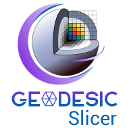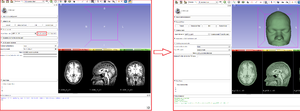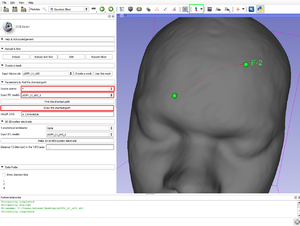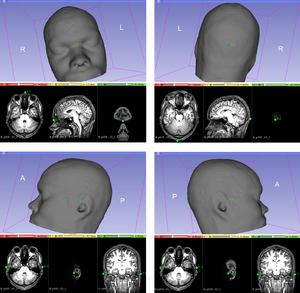Documentation/4.8/Modules/GeodesicSlicer
From Slicer Wiki
Home < Documentation < 4.8 < Modules < GeodesicSlicer
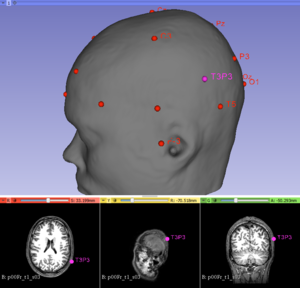
|
For the latest Slicer documentation, visit the read-the-docs. |

The users enters 1) the T1-weighted whole-brain anatomical image 2) Place four points: the nasion, the inion, the left tragus and the right tragus. The program make a 3D mesh morphed to the structural MRI data of a participant and calculates the 10-20 system EEG with T3P3, and outputs the distance between the anatomical target and the T3 electrode.
Introduction and Acknowledgements
|
The module has been developed based on ideas and feedbacks from the community. We would like to especially thank:
- Dr. Olivier Etard, M.D., Ph.D., CHU de Caen.
- Dr. Clément Nathou, M.D., Ph.D., CHU de Caen.
- Dr. Sonia Dollfus, M.D., Ph.D., CHU de Caen, header of ISTS.
- Dr. Csaba Pinter, MSc, Queen's University.
- Dr. Andras Lasso, Ph.D., Queen's University.
Contents
Module Description
This module calculates geodesic path in 3D structure. Thanks to this geodesic path, this module could draw an EEG 10-20 system.
Terminology
- Mesh A mesh or polygon mesh is a collection of vertices, edges and faces that defines the shape of a polyhedral object in 3D computer graphics and solid modeling.
- Shortest path In graph theory, the shortest path problem is the problem of finding a path between two vertices (or nodes) in a graph such that the sum of the weights of its constituent edges is minimized.
- 10-20 EEG system The International 10-20 system is commonly used for electroencephalogram (EEG) electrode placement and to correlate external skull locations with underlying cortical areas.[1]
Use Cases
The overall goal is to allow users to find the shortest paths between nodes in a graph and via the Dijkstra's algorithm to make 10-20 system. This module can be used for:
- Stimulation in psychiatry
- Surgery measurement
- 3D printing
Panels and their use
Create a mesh
A typical straightforward Geodesic Slicer workflow for consists of the following steps:
- Load a volume.nii.
- Enter in the Geodesic Slicer module using either the toolbar or the Modules menu button.
- Press the button "Create a mesh".
- Wait a moment.
- If the segmentation is fine, press the button "Use this mesh".
- If your image was named 't1.nii' the output will be called 't1.stl', in the same directory of your initial image.
- Go to Parameters to find the shortest path or Make 10-20 EEG system electrode section.
Parameters to find the shortest path
- Source points: The list of fiducial points on the curve, since the "Create-and-place Fiducial" button (in green in the figure above).
- Input STL model: The model you use (after "use this mesh", the t1.stl created).
- Find the shortest path: Calculate in centimeter the geodesic (shortest) path via the Dijkstra's algorithm.
- Draw the shortest path: Draw the Dijkstra's algorithm shortest path.
- Length (cm): The length of the current curve is shown in centimeter.
10-20 system electrode
Run the Dijkstra's algorithm to make the 10-20 system electrode distances.
- Source points: The list of fiducial points on the curve, since the "Create-and-place Fiducial" button (in green in the figure above). Four anatomical landmarks are used for the essential positioning of the electrodes (in this order!):
- 1/the nasion
- 2/the inion
- 3/the pre auricular to the left ear
- 4/the pre auricular to the right ear
- Input STL model: The model you use (after "use this mesh", the t1.stl created).
- Press the button "Make 10-20 EEG system electrode" to draw the 10-20 EEG system via the Dijkstra's algorithm.
- Distance T3-Stim in the T3P3 axis are give in centimeters. "Stim" was defined as the stimulation target defined in this article [4].
Information for Developers
The code is available at Github.
References
- ↑ Jasper, H.H. The ten-twenty electrode system of the International Federation. Electroencephalogr. Clin. Neurophysiol., 1958, 10: 370-375
- ↑ Hoffman RE. et al., Transcranial magnetic stimulation of Wernicke’s and Right homologous sites to curtail “voices”: a randomized trial. Biol Psychiatry 2013;73:1008–14
- ↑ Dollfus S. et al., Efficacy of high‐frequency neuronavigated rTMS in auditory verbal hallucinations: a double‐blind controlled study in patients with schizophrenia. Schizophr Bull 2017. In press
- ↑ Briend F. et al., Is T3P3 is the best target to treat patients suffering from schizophrenia with auditory hallucinations?. Brain Stimulation, submitted
